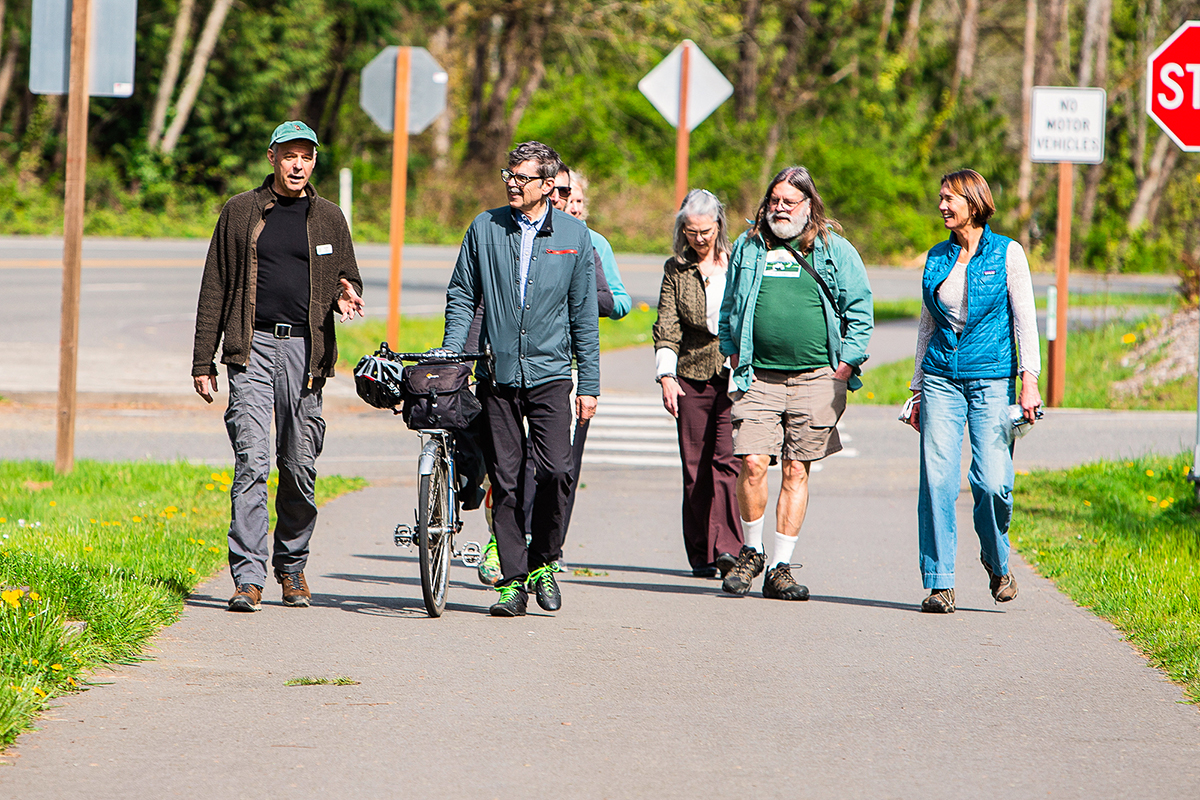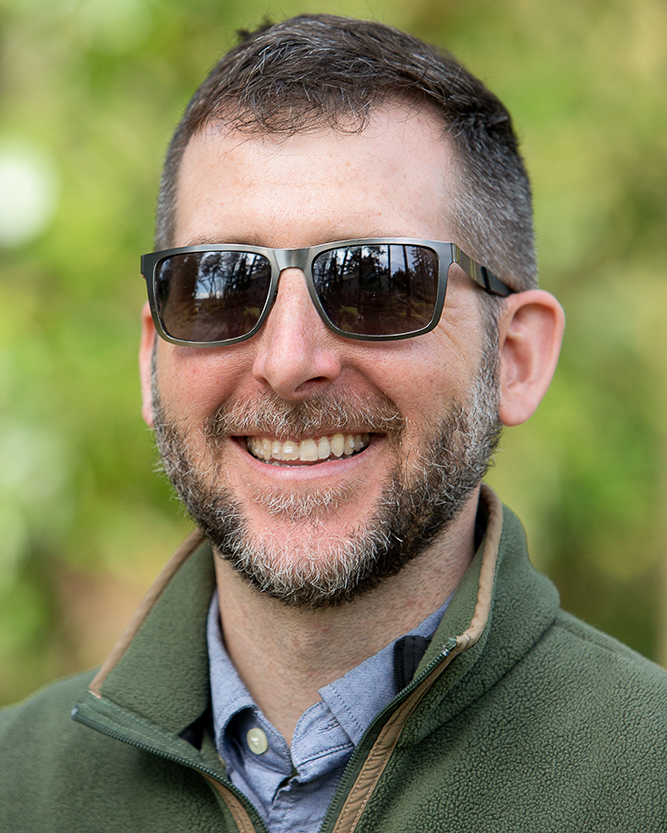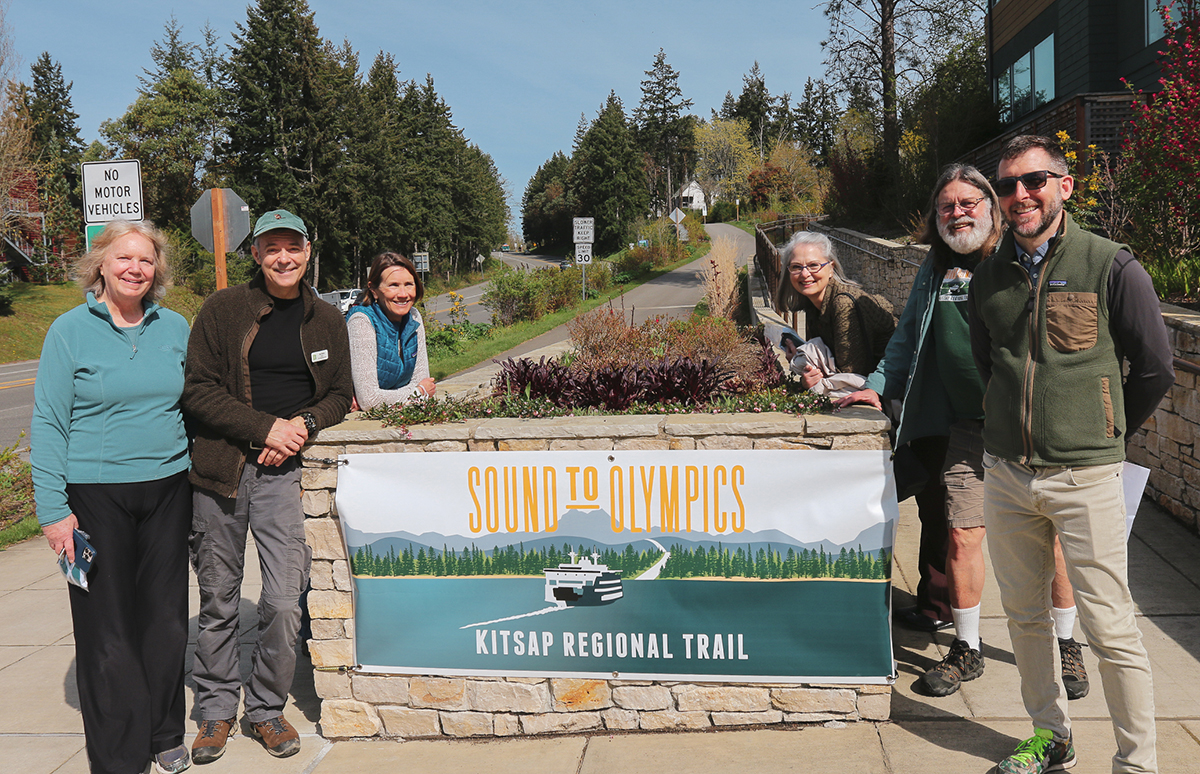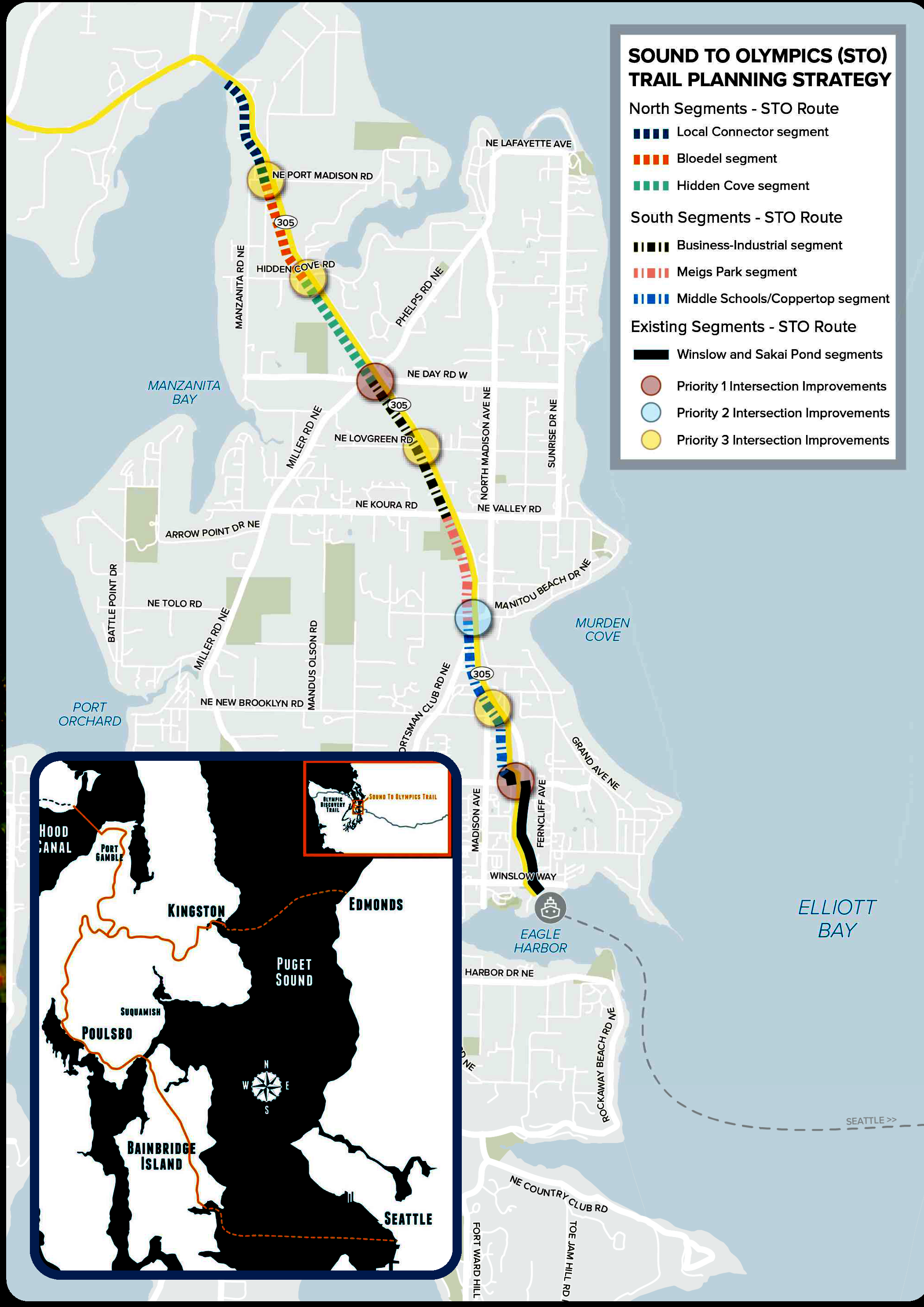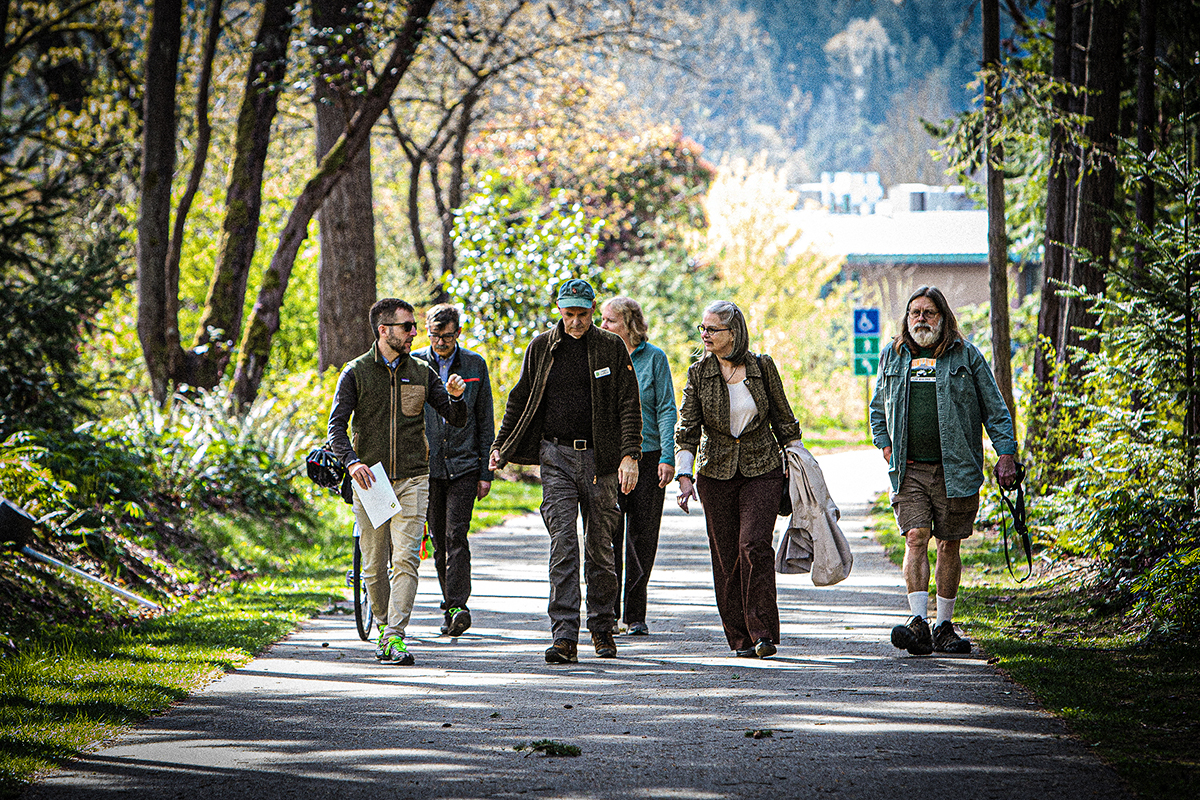In the fullness of a 3,700-mile route, a seven-mile ribbon across a little island in Puget Sound may not seem so grand.
Then again, it’s our seven miles. So the fact that Bainbridge Island’s bit of the Sound to Olympics Trail also falls along the path of the Great American Rail-Trail – a contiguous path that will stretch from the other Washington to this one, crossing a dozen states and entirely walkable and bikeable – that’s turning into kind of a big deal.
That’s what Kevin Belanger, project manager for Washington D.C.-based Rails To Trails Conservancy found during an April visit to Bainbridge Island. Belanger came to spend an hour walking the STO’s Winslow segment with local trails fans, and was greeted by City Hall.
“I really appreciated that the mayor, the city manager, and a city council member came out for a guy from DC they’d never met before, for an hour in the middle of their day,” Belanger said. “I thought that was pretty cool.”
It’s a measure of growing momentum for the STO Trail and the opportunities it presents for safe, nonmotorized transportation both across and around the island – a separated greenway for bikes, hikes, walks, and all manner of clean, sustainable travel.
Greeting Belanger were City Manager Blair King, Mayor Joe Deets, Councilor Leslie Schneider, along with Friends of the STO Trail founder Don Willott and Bainbridge Island Parks Foundation project director Barb Trafton.
Belanger also toured the upper-left corner of the Rail-Trail route in Jefferson and Clallam counties, but his Bainbridge stop was well timed.
The City of Bainbridge Island will soon begin a Sound To Olympics Trail Master Plan, to identify a preferred route along the west side of the highway from Winslow north to the Agate Pass Bridge. The Bainbridge Island Parks Foundation has given $50,000 to the planning effort, with another $25,000 from the Bainbridge Island Metro Park & Recreation District.
“We share a vision for an island connected by safe, accessible trails, and the STO can be the spine for the north end,” said Mary Meier, Bainbridge Island Parks Foundation executive director. “That the STO coincides with a much greater vision for a nationwide trail, it brings color and context to what we’re working toward here and puts it in a much more exciting light.”
The Sound to Olympics Trail is envisioned to run 28 miles, from the Winslow ferry terminal to the Hood Canal Bridge. Bainbridge Island’s portion would be built in seven segments over a number of years, as funding allows. The upcoming Master Plan will include preliminary construction designs for the probable next segment, from Sakai Park to Madison/305.
The City has also applied for federal funding for a Meigs Park segment, from Sportsman/305 to Koura Road. That section would essentially link the main Bainbridge schools campus with the new Bainbridge Island Recreation Center.
“When you see how a kid might soon be able to ride his bike from the middle school all the way out to the recreation center, on a trail that’s separated from car traffic, then the STO vision really comes home,” Meier said. “Tie in connector trails from neighborhoods, and you can see it will be great for recreational use and for all sorts of trips to and from Winslow.”
The City expects to hire a consultant for the STO Master Plan in June, with planning to start this summer.
As the Bainbridge Island STO takes shape over time, it will fill in one more gap in a much longer trail still – one that spans the nation.
Great American Rail Trail
Bainbridge Islanders may be surprised to discover that we fall along the Great American Rail-Trail, given that the transcontinental railroad – for obvious geographic reasons – never crossed the island.
In fact, only about three-fourths of the 3,700-mile Rail-Trail route falls on old rail corridors. The rest of the route, which crosses 12 states total, is being filled in piece by piece at the local level. The Rail-Trail is about 53 percent complete, with some 1,700 miles to go and about 88 identified gaps to be filled in.
When finished, it will serve an estimated 50 million people living within 50 miles of the trail.
The route west might have stopped in Seattle or veered to southwest Washington. But the Conservancy found that the Sound to Olympics Trail was already in the works, and the Olympic Discovery Trail – from Port Townsend to the Pacific Ocean – is already there. So Bainbridge Island, with no railroad, finds itself one more link in the Great American Rail-Trail.
To see how the gaps are being filled in, consider: Belanger’s Washington state visit was timed to the April 8 re-opening of the historic Beverly Bridge across the Columbia River near Beverly, Wash. Built in 1909 for trains running the Great Milwaukee Road between Chicago and Tacoma, the bridge was abandoned in 1980 and sat disused for more than 40 years.
Now restored and dedicated for hikers and bicyclists, the bridge is a key link in the 285-mile Palouse-to-Cascades Trail. Gov. Jay Inslee trekked over for the ribbon cutting, which drew 300 people. Washington State’s section of the trail is now 67 percent percent complete, making the drive to complete our Bainbridge Island trail section even more compelling.
It’s a multi-year, multi-faceted vision. But every journey begins with a first step.
Belanger notes that federal funding for alternative transportation is up 70 percent, meaning more opportunities for regional and local projects that get people out of cars and onto trails.
What does Bainbridge Island have going for it? As Belanger would have it, a “trifecta of awesomeness” – public support, political will, and the “irreplicable beauty” of the Pacific Northwest.
“The enthusiasm is off the charts up here,” Belanger said. “I was amazed by how many people we met with who were clamoring to talk about the trail, they were so excited.”
Rails To Trails Conservancy this week released an independent study on the economic benefits of a completed Great American Rail-Trail, and the many communities along the way. In Washington state alone, the study estimates $25 million in new visitor spending each year by trail trekkers, along with jobs, local tax revenue and other spinoffs.
Bainbridge Island would get its cut, whether visitors stay to experience the local trails and culture, or just ride the STO across the island to points west but stop in Winslow for a sandwich and beer.
“Trails are not just nice-to-haves, they are necessities,” Belanger said. “When you connect them to each other, that interest in trails and the ability of a trail to provide economic development is compounded.
“Once you face things to the trail, once you have signs that say ‘here’s how you get to the downtown,’ that is how you activate the trail. Bainbridge Island is in a good place to do that.”
